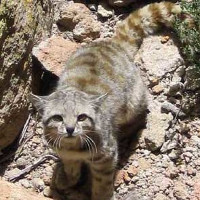 |
Andean Cat |
|
He is a wild animal |
Origin |
South America | |
Translation |
Francis Vandersteen |
| The possession of this animal is not authorized Royal Decree establishing the list of mammals not kept for production purposes that may be kept (M.B. 24.08.2009) |
| The Andean Cat is a species of feline found in South America. It is a small feline that lives at high altitude and specializes in hunting the rodents that live there: chinchillas and viscaches. Since man has caused the virtual disappearance of its favorite prey and the reduction of its habitat, it is a rarely seen species and considered to be in danger of extinction. The Andean Cat is a small feline, weighing between three and eight kilos, with Peruvian males weighing four kilos. Shoulder height reaches 25 to 35 cm, while body length is 95 to 130 cm. The beige muzzle is highlighted by a black line running down the face from the outer corner of the eye. The nose is black. The sense of hearing is powerful, thanks to highly developed tympanic bullae, characteristic of animals living in arid environments with very little plant cover. For example, a similar development of tympanic bullae is observed in the Sand Cat. The Andean Cat has a silvery-grey coat with brownish stripes running from the back to the flanks, making it a good camouflage among rocks. The belly is white with dark spots. The front legs and chest are marked with dark gray stripes. The soft, fine fur is thicker on the back and tail. Hair length is 40 mm on the back and 35 mm on the tail. The tail, which accounts for two-thirds of its total length, is marked with around seven dark rings; the tip is black. Gray fur is typical of mountain cats such as the snow leopard and manul. The Andean Cat is a specialized predator, hunting viscache by day and chinchilla by night. It may also feed on birds and reptiles in addition to its usual diet. When hunting, it lies in ambush, hidden in the rocks, then, at a relatively short distance from its prey, leaps over the scree in rapid pursuit. The mink and chinchilla, both high-mountain rodents, are known to change direction abruptly as they flee: the Andes Cat's long tail enables it to turn quickly and keep its balance as it pursues its prey. In 1991, German wildlife photographer Günter Ziesler, while working with mink, spotted an Andean cat leaping over rocks, chasing mink in an extravagant dance. The cat's acute hearing may be used for hunting. No information is available on the breeding season, gestation, number and rearing of kittens. The female probably protects her young in a den hidden in the rocks. The Andean Cat is probably a solitary feline. Territory size is estimated at 10 km2 in the Tucuman region (Argentina). The Andean Cat is one of the most misunderstood felines in the world, and probably the rarest of the American felines. Its similarity to the Pampas Cat and its inhospitable habitat make it difficult to study. Current knowledge of the Andean Cat comes from the rare skins and skulls held in zoos, sporadic observations in the wild and genetic studies on feces. Scientific studies on this feline are often conducted in conjunction with those on other small Andean carnivores. The very first field research was carried out in 1998 with funding from the La Torbiera Zoological Society in Argentina. |






 English (United Kingdom)
English (United Kingdom)